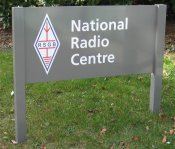 The weekend of the 25th and 26th of February 2012, saw the opening of the brand new RSGB ‘National Radio Centre’, the showpiece for the amateur radio hobby in the UK.
The weekend of the 25th and 26th of February 2012, saw the opening of the brand new RSGB ‘National Radio Centre’, the showpiece for the amateur radio hobby in the UK.
The new National Radio Centre is located in the grounds of the historic Bletchley Park, home of the codebreakers, close to Milton Keynes. Two of the Essex Ham team took a trip to Bletchley Park this weekend, and stopped in at the new Centre to meet the team, have a look around, and take a few pictures.
Here’s our report of what we discovered.
| This article was written in 2012. There have been several changes since then, and we’ll update this article after our next trip. Note now that the NRC is now open 6 days a week, and has seen some significant changes. Note too that RSGB members get free entry to Bletchley Park with a voucher from the RSGB website. For the latest on the NRC, go to www.nationalradiocentre.com |
Bletchley Park
If you’ve not been to Bletchley Park, and you have any kind of interest in radio – then you should go. The emphasis is, quite rightly, on codebreaking, with lots of material on the Bombe, Enigma machines, Colossus and the pioneering work of Alan Turin. At the weekends, there’s a display of various radio and communications equipment, including sky radio transceivers in Hut 1, plus a reproduction of the Y Station outpost and all sorts of radio and early computing equipment. It’s a great day out for anyone with an interest in radio, WWII or computing.
You can find more information on visiting the site at www.bletchleypark.org.uk
National Radio Centre
The new RSGB complex is very close to the main Bletchley Park entrance, and one of the first buildings to catch our eye on the way in. It a single-storey green building close to the car park and the main Block B building.
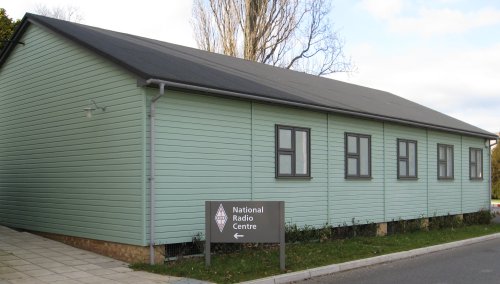
On entering, we were greeted by two very friendly chaps, who on finding out that we were both hams, let us through the magic curtain without needing to introduce us to the hobby explain what the RSGB offers.
On going through into the Centre, we were struck by the clean and professional feel. The first stop is a small video presentation area, where you can sit and watch a short film about how important radio communications is to us all. The video presentation looked very slick, but I must confess that we didn’t sit through the presentation, as we were keen to see what else was on offer inside.
On rounding the corner, we were able to see “The History of Radio Communications”, a small area documenting the history of radio and radio amateurs, with some early ham equipment right up to today’s amateur radio, with topics such as ham satellites and ISS contacts.
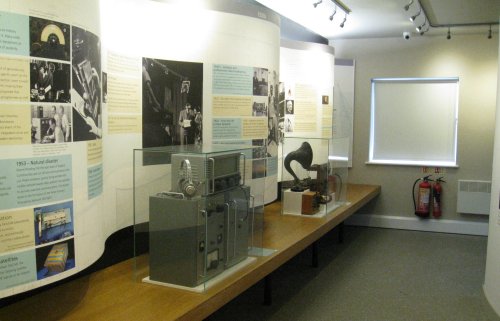
Around the next corner, we found a few interactive displays. Kids love playing with buttons, and taking a leaf from London’s Science Museum, there’s some perspex boxes with various controls to play with. You can experiment with tuning, and see a waveform of your voice from a fixed mic.
Running along the wall is a depiction of “The Radio Spectrum” with an explanation of what can be found where, with touch screen panels showing more information – ideal for educating young minds into the basics of radio, and what the spectrum is used for.
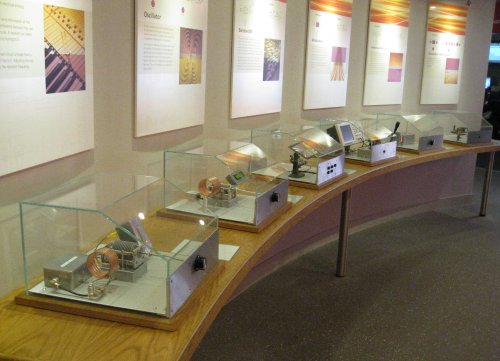
The final stop for us, was GB3RS, the amateur radio station, where those new to the hobby can get an introduction to today’s hobby, and let the public try their hand at an assisted QSO.
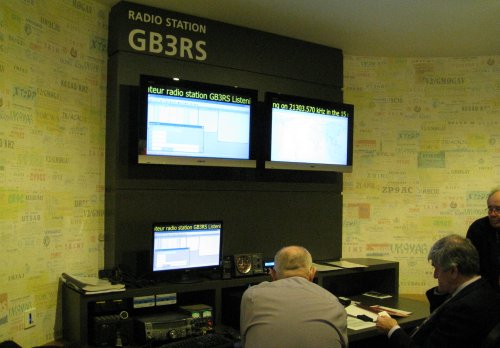
A lot of work has clearly gone into making this the centrepiece of the National Radio Centre. The main station area is decorated with a backdrop series of images representing callsigns and QSL cards, with the station itself being a visually-appealing black work area with two large monitors showing scrolling messages with the working frequency and band.
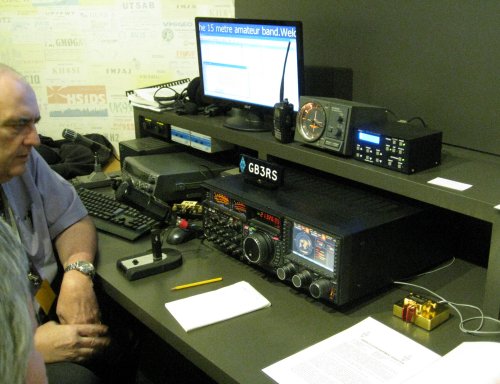
The configuration we saw was dual-operation, and at the time we visited, the team were swinging the beam around to pull in a station from Latvia on 15 metres. I took a short video clip which I’ll try to upload in the next few days.
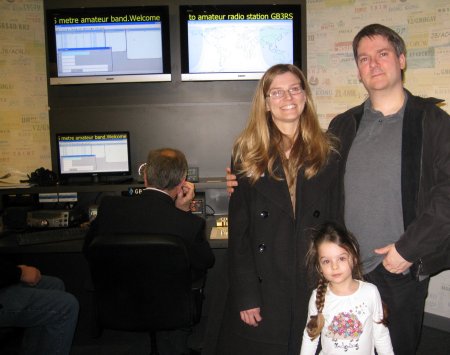
Sarah, little Kathryn and I were made to feel very welcome by the team, and to discuss the Centre and the plans for its future. We got the impression that anyone not familiar with what amateur radio is all about, would be able to get a good feel for how to make contacts with stations around the world and to get hands-on with the hobby.
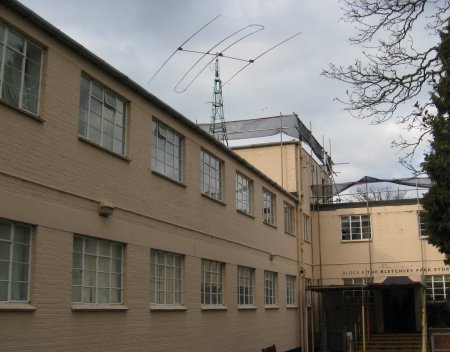
Our impressions?
Overall, we were certainly impressed. The Centre has a very clean and professional feel, and it does an excellent job of extolling the importance of radio communications, and selling the hobby.
As it’s the first week of operation, there are still things to do ahead of the National Radio Centre’s formal opening later this year. At the moment, the centre is only staffed and operational on Thursday, Saturday and Sunday, and this is due to expand as and when more volunteers become available.
Hopefully as work continues, the Centre will see more promotion for the hobby – for example, we noticed the absence of any literature on how to take your first step to get a licence, or information on Foundation courses. We didn’t notice any RSGB merchandise, books and membership forms on display, but no doubt these are all things that have been considered and will be in place ahead of the formal opening.
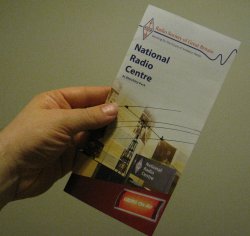
As the Centre is so new, it doesn’t yet appear in the main Bletchley Park guide or maps, and so there’s a danger that until there is reference to the Centre in a few strategic places, plus some signposting, many visitors to BP may not notice it’s there, or that it’s open to the public, free, and a place worth exploring.
On the positive side, we did see a number of “RSGB National Radio Centre” leaflets (pictured here) at all of the information desks and leaflet racks, which will no doubt help to get the Centre to be discovered, and the leaflet does contain information on how to contact the RSGB.
Entrance to Bletchley Park is £12 for adults, but the National Radio Centre is free, and you’re not obliged to pay for entry to Bletchley Park if you just want to check out the National Radio Centre.
More on the NRC at www.nationalradiocentre.com


Pete & Sarah,
Great, thanks for writing so much so soon.
John G8DET.
Excellent article on what was a mystery project to most people. As a result, I am more likely to re-visit BP and pay a visit to the centre. 73 de David G3UNA Chairman RADARS
Great article.
My family and I will hopefully be going this summer when we visit England for a holiday.
Chris
EI1628
A very interesting and informative report.
A visit to BP beckons soon!!
73
John G8DZH
Thank you for providing such an informative report on the opening. Very pleased to read your positive comments after hearing so much ‘doom & gloom’ about it in some of the newsgroups. We all need to hope that once its on the ‘map’, it will provide the shop window the hobby needs to survive. Thank goodness the new team trying to sort out our National Society did not wield the axe [the easy thing to have done] and stood their ground to let it go forward. Hopefully, our investment will pay dividends with a stream of new members joining us as a result of its location and how its all been put together,
Jim G3OJI
A fab informative article and some super images of the NRC, which gives the reader a great feel for the place. I am certain the NRC with the support of the RSGB and the UK’s Amateur fraternity will be an excellent asset for our great hobby and I sincerely hope it will be there for many years to come. So goodbye and 73 doom and gloom, hello NRC! As the NRC is only 1/2 hour drive from the QTH a weekend visit is going to be real soon. Your excellent report gives me the same enthusiasm as I had experienced last summer, when visiting the Marconi Centre at Poldhu Cornwall, a mecca for all Radio Amateurs I would hasten to add and the cable wieless museum at Porthcurno.
Thanks for the article and the insight, James G7DPE
Nice report. I will certainly be re-visiting BP to have a look around the centre. It’s a great day out.
Neale G3VFX
We’re looking forward to arranging a club visit in the near future. Congratulations on what looks like a great tool for promoting the hobby and the RSGB.
73 de Colin G1IVG
Welland Valley Amateur Radio Society
http://www.wvars.com
Good informative & interesting article / report with good photos. Good comment also that RSGB merchandise & more free “giveaway” leaflets on Amateur Radio should be readily available. Thanks to Pete, Sarah & young Kathryn (a budding young licensee if i’ve ever seen one!)
73, de Mario – G2DPA.
Visited Bletchley Park a few years ago and it was in good shape then but looks a 100% better now, thanks for taking the time to show us the pictures and tell us of your experience, glad you enjoyed your visit, I shall return one day for another look round. Best 73 from the Algarve. CT7ACG/G3VCQ.
Mni tnx for fb report…
Good Luck to the NRC, looking foward to the opening, Edgware&District RS G3ASR (75th year) members will visit soon.
Hank G0FAB
As someone part of the Board at the time, who suggested that we move to the country and re-visit the idea of a possible link with Bletchley Park to reais our profile it’s most gratifying to read that the original concept of presenting the world of communications to the public , is coming to fruition, in such a positive way. It’s my belief that this project is the most significant thing we have collectively done in recent times , laying a foundation on which to build. I know it’s not been easy to get this far and many people are to be commended and thanked for, “sticking with it ” Putting the RSGB’s home station on the air every day of the week , with someone there to expalin things can do wonders for us , on a number of levels . An original suggestion was to see if it would be possible for affiliated radio clubs to possibly camp/caravan or B & B and book time on the station to make this happen. What a win-win situation for everyone and a great membership benefit ! Here’s hoping the project goes from strength to strength – Richard G3UGF
Thank you for the insight, after being very disappointed a couple of years ago with a visit to BP I am glad to see that the NRC has at last opened and from these pictures the information has been thoughtfully displayed. I do hope that the NRC is open everyday as it would be great to see everyone visiting BP walking through the doors here. To have to pay to get into BP to have not been able to see the station there was a big disappointment. I am sure arrangements could be made with Radio clubs, RAYNET groups etc to man the station there. The rest of us also need to play our part in answering any calls heard from GB3RS too. I hope this projects now achieves what it was intend to do! Helen – GW7AAU
That looks good. Well done to all involved. Will the National Radio Centre leaflet be available as a PDF to download?
Visited Bletchley Park on March 17th with PA1FZH, PA1IJF and PD1ML.
Thank you for showing us the station and we were very proud that we were the first visiters that brought the callsign GB3RS “on air” from the brand new RSGB “National Radio Centre”.
Cor, PE1PTQ
We visited Bletchley Park this weekend. We found out that that that the NRC was on the site and we met the crew. Excelent display and excelent radio. Alan, thank you very much. 73 de PA1FZH, PE1PTQ, PD1ML and PA1IJF.
Just found this web site and do not remember any one taking my photo. Was shocked to notice how bald i am!!! Think i will take up wearing a hat from now on.
Do come and visit us I am there every Thursday.
Peter
G4XEX
The BIG bald op in the photos.
Visited BP this weekend but had difficulty finding the RSGB display – no visible signs and had to ask for directions.
However, once found the exhibition was excellent as was the centrepiece. The Ops there were very friendly and we had a decent chat.
One question; does the Society not think that having an all singing, all dancing top of the range transceiver as the centrepiece might scare persons who think its going to cost them in excess that £10k to start?
Perhaps a few images of others shacks could offset that.
I just returned from visiting England (23 June to 30 June 2013). First on my list was to visit Bletchley Park on Monday, 23 June. It was very interesting particularly for a ham like myself. We got an excellent guided tour. I had done quite a bit of reading about the Enigma machine and the work that had been done during WWII at Bletchley. Much to my disappointment the ham station, GB3RS, was closed on that particular Monday. I did, however, see the beam antenna on the roof. I am active on 20-meter SSB and possibly sometime I will be able to contact GB3RS. Keep up the good work of promoting amateur radio.
73,
Fred Mason, W5SLT
Fort Worth, Texas, USA
Nice Blog. Thanks for posting this. We are also in the same fields . For more information visit our website http://bit.ly/17Muz4y.